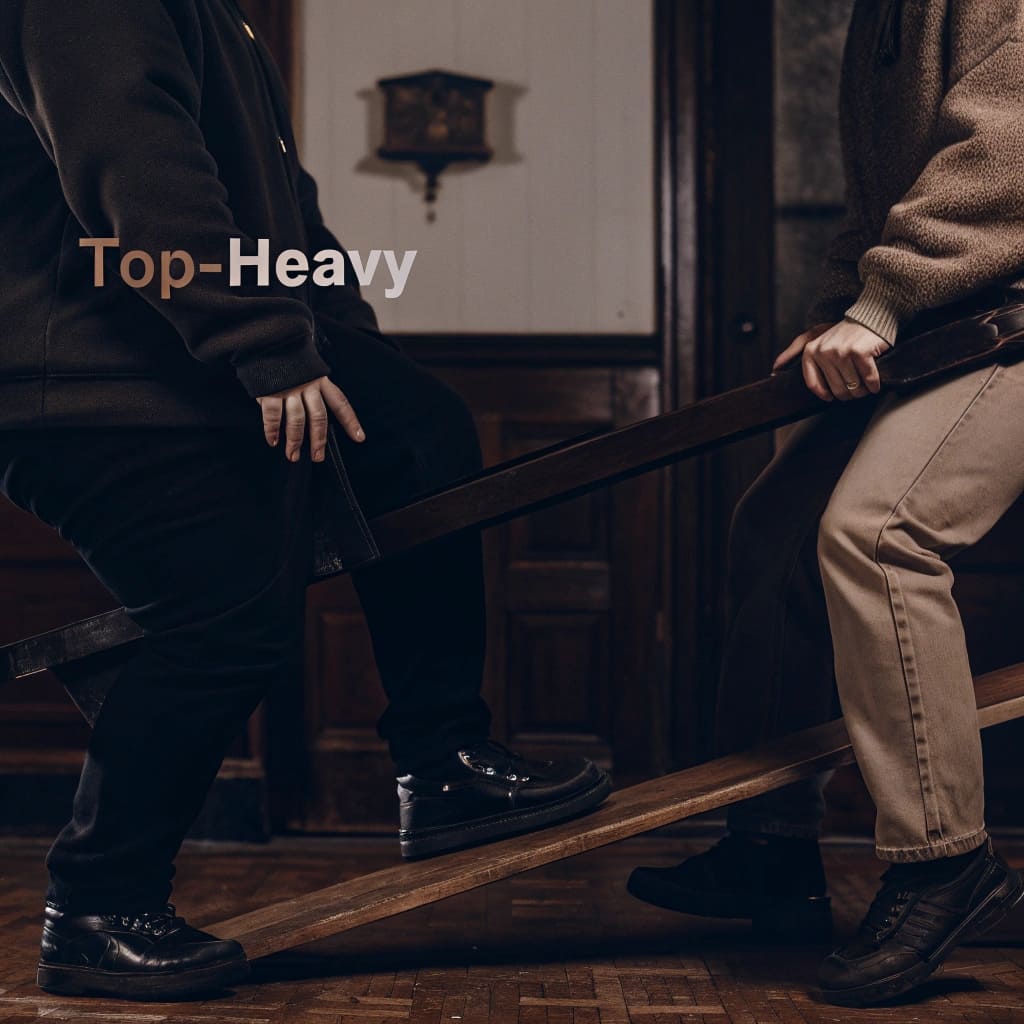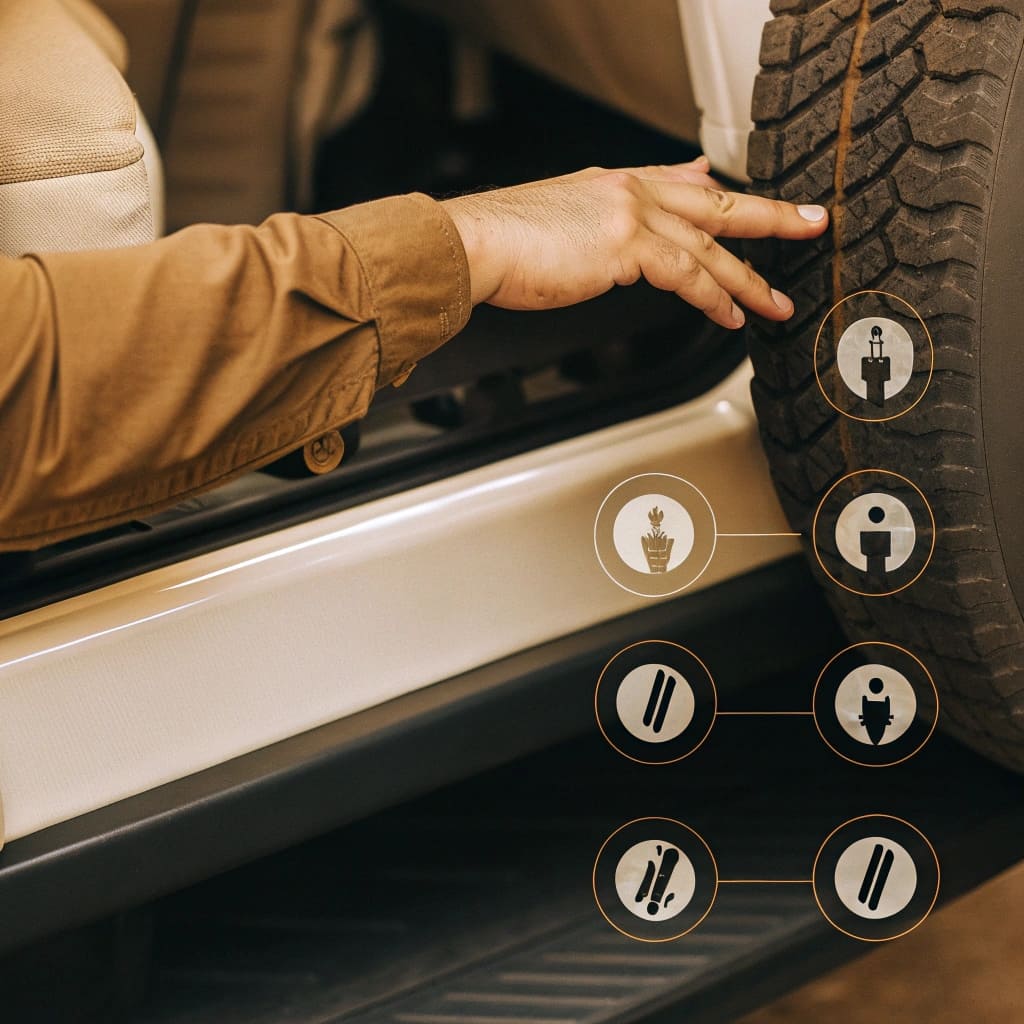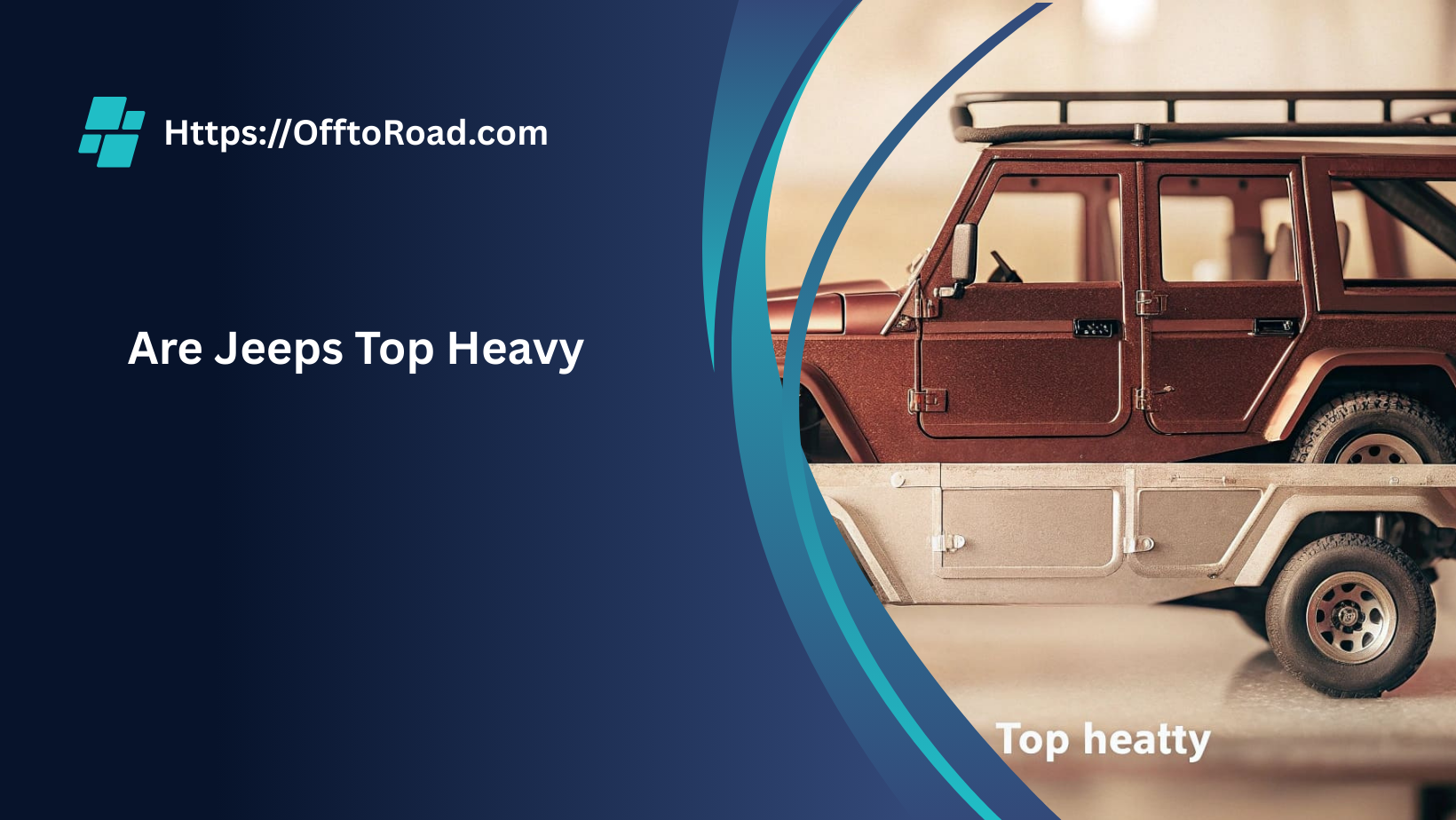So, you’re thinking about getting a Jeep—or maybe you already have one parked in your driveway. Either way, there’s a question that pops up a lot:
“Are Jeeps top-heavy?”
The quick answer? Yeah, they kind of are. But don’t let that scare you! It doesn’t mean they’re unsafe or unstable—it just means you need to understand how they’re built and how to drive them smartly.
Let me walk you through it in plain, easy-to-understand words.
What Does “Top-Heavy” Mean?

When we say a vehicle is “top-heavy,” it means more of its weight sits higher up. So, when you take a sharp turn or drive on a steep slope, the vehicle can feel less balanced—and it may tip more easily than a regular car.
Why Are Jeeps Top-Heavy?
There are a few good reasons why Jeeps have this top-heavy feel:
- High Ground Clearance – Jeeps are built to handle rough trails, mud, and rocks, so they sit higher off the ground. This makes the center of gravity higher.
- Tall, Boxy Design – Models like the Wrangler are shaped upright and narrow. That extra height adds more weight up top.
- Lift Kits & Bigger Tires – A lot of Jeep owners install lift kits, larger tires, or roof racks. These upgrades look awesome and help off-road performance, but they can also raise the center of gravity even more.
- Adventure-Ready Build – Jeeps are made for wild roads, not just highways. So this top-heavy design is actually part of their rugged charm.
So yes, it’s true—Jeeps naturally ride a bit higher, and that’s part of what makes them so capable on rough terrain.
Now that we know why Jeeps can feel a bit top-heavy, let’s break down which models stand out the most.”
Here’s a quick comparison of common Jeep models and how top-heavy they feel:
| Jeep Model | Top-Heavy? | Why? |
| Wrangler | Yes | Very tall and narrow body |
| Gladiator | Yes | Similar to Wrangler, but longer |
| Grand Cherokee | Less | Wider and more balanced |
| Renegade/Compass | No | Compact and shaped like regular SUVs |
Is a Top-Heavy Jeep Dangerous?
Not really—but you have to drive carefully. If you drive too fast in turns, or make quick movements, the Jeep can become unstable.
But don’t worry. New Jeeps come with safety features like:
- Electronic stability control
- Roll-over protection
- Better suspension systems
Also Read: https://offtoroad.com/are-jeeps-trucks/
How to Drive a Top-Heavy Jeep Safely
Here are a few easy tips:
- Take turns slowly – Don’t speed in curves.
- Avoid sharp swerves – Be smooth with your steering.
- Keep heavy things low – Don’t put heavy stuff on the roof.
- Upgrade your suspension if you lift the Jeep.
- Get used to your Jeep’s feel before off-roading.
Final Words:
So yes, Jeeps are a bit top-heavy, especially models like the Wrangler or Gladiator. But that’s because they are made for off-road fun.
If you drive smartly and don’t rush in turns, your Jeep will stay safe and stable.
Jeeps are all about freedom, style, and going where other cars can’t go. Just respect the design, and you’ll enjoy the ride for years to come!
Is the Jeep Wrangler a Good Heavy-Duty Work Car?
Alright, let’s be honest here—the Jeep Wrangler looks like it could handle just about anything, right? And while it’s definitely tough and rugged, when it comes to serious job site tasks—like towing heavy trailers or hauling piles of tools—it’s not exactly built for that kind of workload.
Let me break it down in simple terms.
First off, space is a bit of an issue:
If you’re thinking about stuffing it full of gear, lumber, or bulky tools, you might run out of room faster than you expect. The 2-door model especially has limited cargo space, and even the 4-door Wrangler Unlimited isn’t as roomy as, say, a pickup truck bed.
Now, here’s something people often ask about—how much can it tow?
Most Wranglers can pull around 2,000 to 3,500 pounds. That’s perfectly fine for a small trailer or some lighter equipment—but it’s nowhere close to what heavy-duty trucks can do. Just for comparison, a Ford F-150 can tow over 10,000 pounds without even sweating.

And then there’s fuel economy:
Let’s say your job has you driving all over town—well, the Wrangler might not be your wallet’s best friend. Depending on the model and year, you’re looking at around 15 to 22 miles per gallon. That means more frequent fill-ups and higher fuel costs in the long run.
But hey, it’s not all bad news:
Where the Wrangler really shines is in off-road or rough work environments. If your job takes you off the pavement—maybe onto farms, trails, or snowy backroads—the Wrangler’s legendary 4×4 capabilities truly come in handy. It’s great for folks doing land surveys, farm work, or heading out into nature for inspections.
Still, if you’re needing something that can handle bigger loads on a daily basis:
You might want to look at a pickup truck instead. Options like the Ford F-150, Ram 2500, or Chevy Silverado HD are better built for heavy hauling and towing. They’ve got the space, the power, and the durability that heavy-duty jobs really call for.
Final Thoughts
So here’s the bottom line:
If you’re looking for a rugged ride that’s fun to drive, handles light-duty jobs, and can get you through muddy trails or snowy fields—the Wrangler’s a solid choice.
But if your day-to-day work includes towing big trailers, carrying heavy equipment, or loading up with bulky materials, you’re probably better off with a full-size truck. The Wrangler is awesome for adventure and off-road tasks, but for heavy-duty job site work? It’s more of a weekend warrior than a full-time workhorse.
What might be a better choice?
If you really need something for heavy lifting, towing, and hauling, pickup trucks like the Ford F-150, Ram 2500, or Chevy Silverado HD are much better options. These trucks are made for the hard stuff—they’ve got the power, space, and strength that job sites demand.
Also Read: https://offtoroad.com/jeep-4xe-plug-type/
Final Thoughts:
So, to sum it up:
If you’re looking for a reliable, tough vehicle for serious work—like hauling big loads or towing heavy trailers—the Wrangler might not be your best bet.
But if you’re after something adventurous, stylish, and capable of handling light-duty jobs in rough places, the Wrangler could still work for you. Just know its limits, and you’ll enjoy the ride a lot more.
Does a Jeep Wrangler Tip Over Easily?
If you’re thinking about getting a Jeep Wrangler—or maybe you already have one—you might be wondering: does it tip over easily? It’s a common concern, especially since Wranglers look tall and narrow. So let’s go over the facts in a simple, honest way.
The Wrangler’s Design Makes It More Top-Heavy:
The Wrangler is made for off-road adventure. That’s why it sits higher off the ground and has a more upright shape. This design helps it handle rocks, trails, and mud—but it also means the Wrangler has a higher center of gravity. And when a vehicle has more weight up top, it can be a bit more likely to tip, especially during fast turns or steep off-road driving.
It Doesn’t Tip Over Easily on Normal Roads:
Now here’s the good news—Wranglers don’t just tip over out of nowhere. If you’re driving normally on city streets or highways, and you’re not making super sharp turns at high speeds, you really don’t have to worry. In fact, modern Wranglers are much more stable than older ones, thanks to better design and updated safety features.
Like any vehicle, the Wrangler can tip if you push it too far. The risk goes up when you add a lift kit without upgrading your suspension, carry heavy gear on the roof, or go off-roading on steep and uneven ground. Also, taking corners too fast or swerving suddenly can throw the balance off. These are the moments when you’ll want to be extra careful.
Wrangler Safety Features Help a Lot:
Jeep has added smart features to help keep the Wrangler steady. Things like Electronic Stability Control, Roll Mitigation, and Traction Control all work behind the scenes to keep your tires grounded and your vehicle balanced. These systems kick in when they sense the Jeep might lose control—so they really add an extra layer of protection.
How to Drive a Wrangler Safely?

Honestly, staying safe in a Wrangler isn’t hard. Just follow a few simple habits. Slow down when turning, avoid sudden steering movements, and try not to load heavy things on the roof. If you’ve lifted your Jeep for off-roading, make sure your suspension matches the new height. And when you’re out on rough terrain, take it slow and smart—know your Jeep’s limits.
Should You Worry?
So, does a Jeep Wrangler tip over easily? Not really—but it is more likely than a low, wide car or SUV. The key is understanding how the Wrangler is built and driving it the right way. Treat it with a bit of respect, don’t rush the corners, and enjoy the adventure it’s made for. With the right approach, your Wrangler can be safe, steady, and a whole lot of fun.
FAQ’s
1. Can I make my Jeep less top-heavy?
That’s a smart question! Honestly, yes, you can make your Jeep feel less top-heavy. For starters, try to avoid piling heavy gear up on the roof unless you really need to. Also, if you’re thinking about lifting your Jeep, consider getting a balanced lift kit and upgrading your suspension too.
These little tweaks help lower the center of gravity, making your Jeep feel more steady—especially when you’re turning or driving off-road. So, with a few simple changes, you can keep your Jeep feeling safe and solid.
2. Do all off-road vehicles feel top-heavy like Jeeps?
I get why you’d wonder that! Not every off-road vehicle feels as top-heavy as a Jeep Wrangler. Some trucks and SUVs have wider, more stable designs that keep them balanced better.
But here’s the thing—all off-road vehicles usually sit higher than regular cars because they need that extra clearance for rough terrain. So, while many feel a bit top-heavy, Jeeps just tend to stand out more because of their boxy and narrow shape. It’s just part of the adventure package!
3. Is it safe to take a Jeep on the highway if it’s top-heavy?
Great question, and the short answer is yes—it’s safe! Driving a Jeep on the highway is totally doable, even if it’s a bit top-heavy. The trick is to be mindful when you’re changing lanes or going around curves.
Try to avoid sudden sharp turns or speeding through bends. When you drive smoothly and keep things steady, your Jeep handles highway speeds just fine. So, no need to worry—just drive smart and you’ll be good to go.
4. Does a soft top or hard top affect how top-heavy a Jeep feels?
This is something a lot of Jeep owners ask! The hard top does weigh a little more than a soft top, which means it adds a bit of weight higher up on the vehicle. But honestly, the difference isn’t huge, and most drivers won’t notice much of a change.
What really makes a bigger impact is how much gear you carry on the roof or if you’ve made big modifications like lifts. So, while it does make a small difference, it’s not something to stress about.
5. Can I safely lift my Jeep without making it too top-heavy?
Yes, you can—and that’s a smart move if you want to keep your Jeep safe and fun to drive. The key here is doing it right. If you’re lifting your Jeep, make sure to upgrade your suspension and maybe widen your tires to help balance things out.
Some lift kits are actually designed to keep your Jeep’s center of gravity as low as possible, even with the extra height. So, if you take your time and pick the right parts, you can lift your Jeep without it feeling wobbly or unsafe.
Conclusion
So, to wrap it all up, while Jeeps are a little top-heavy because of how they’re built, that doesn’t mean you need to worry. If you just take it slow on turns and avoid putting heavy things on the roof, your Jeep will feel steady and safe.
Plus, once you get used to it, driving a Jeep is all about having fun and enjoying the freedom to go anywhere. Just keep these tips in mind, and your Jeep adventures will be smooth and exciting!
Also Read: https://offtoroad.com/what-year-did-jeep-wranglers-get-backup-cameras/
Also Read: https://offtoroad.com/can-235-80r17-fit-jeep-renegade-trailhawk/
Also Read: https://offtoroad.com/how-much-to-wrap-a-jeep-wrangler/
